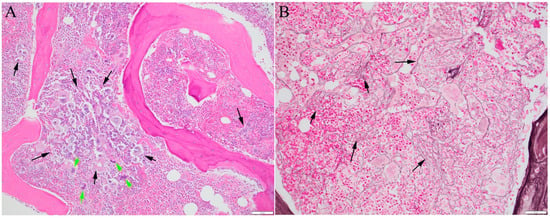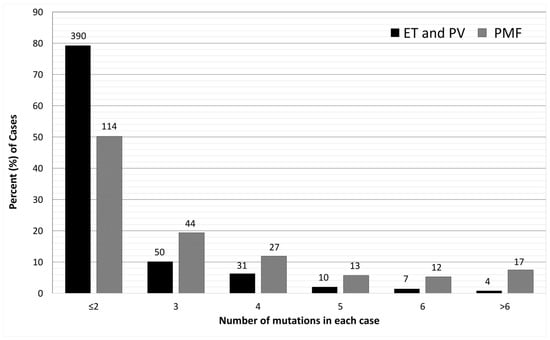Myeloproliferative neoplasms (MPNs) are a group of myeloid neoplasms characterized by bone marrow hyperplasia and overproduction of at least one lineage of blood cells. The current subclassification of MPNs is based on changes in blood cell counts, and hematopoietic lineages in the bone marrow that display hyperplasia and dysplasia. Primary myelofibrosis (PMF) is a subtype of
BCR::ABL1-negative classic MPN, which also includes polycythemia vera (PV) and essential thrombocythemia (ET). The proliferation of abnormal megakaryocytes and varying degrees of fibrosis are defining features of PMF. PMF also typically presents with splenomegaly due to granulocytic proliferation and extramedullary hematopoiesis, and many patients show constitutional symptoms of a hypermetabolic state due to changes in inflammatory cytokines. Recent updates of the 5th edition of the World Health Organization (WHO) Classification of Hematolymphoid Tumors (WHO-HAEM5)
[1] and the International Consensus Classification (ICC)
[2] have further refined PMF into early, prefibrotic, and overt fibrotic stages. Secondary myelofibrosis (SMF) can present in the later stages of other myeloid neoplasms, particularly other MPNs (post-ET and post-PV MF) and myelodysplastic/myeloproliferative neoplasms (MDS/MPN). It is necessary to differentiate between ET and PV with mild MF and prefibrotic PMF
[1]. However, post-PV and post-ET SMF
[3][4][3,4] can be indistinguishable from PMF when no clear clinical history of PV or ET is documented in patients presenting with myelofibrosis (
Figure 1). PMF and SMF are frequently studied together and are clinically managed similarly. Bone marrow fibrosis can also occur in reactive conditions, such as infections, autoimmune disorders, and other malignancies. In the published literature, the term MF is usually reserved for bone marrow fibrosis related to myeloid neoplasms; bone marrow fibrosis is a general term used for other secondary fibrosis
[5].
2. The Driver Mutations
The discovery of recurrent mutations in Janus kinase 2 (
JAK2), calreticulin (
CALR), and myeloproliferative leukemia oncogene (
MPL) as driver mutations has transformed the diagnostic approach of MPN, as evident in the revisions of WHO classifications
[1][8][9][1,8,9]. Clonal evidence, supported by the presence of a driver or other mutations commonly associated with various myeloid neoplasms, is crucial for definitive diagnosis. Both
JAK2 and
MPL encode proteins that activate the JAK/STAT signaling pathway, which is essential for signal transduction from erythropoietin (EPO), thrombopoietin (TPO), and granulocyte colony-stimulating factor (G-CSF) receptors. The pathobiology and diagnostic relevance of activating mutations in
JAK2,
CALR, and
MPL have been extensively investigated in the clinical setting.
JAK2 V617F mutation is associated with an increased risk of thrombosis, and a high allele burden is associated with disease progression
[10].
MPL encodes the TPO receptor, and mutations, usually at codon W515, lead to constitutively active signaling independent of ligand binding. The interaction between MPL and altered calreticulin encoded by mutant
CALR results in MPL hyperactivity
[11].
CALR and
MPL mutations are typically exclusive to ET and PMF and very rarely occur in PV
[10]; however,
JAK2 V617F mutation remains the most common driver mutation in PMF, reported in 50–60% of cases, followed by
CALR mutations in 25–35% and
MPL mutations in 5–10% cases
[12][13][12,13]. Interestingly,
JAK2 exon 12 mutations
[14], which are also activating mutations, have not been documented in ET or PMF. All oncogenic
CALR mutations are frame-shifting insertions or deletions (indels) that alter the C-terminal end of calreticulin from negatively charged acidic amino acids, aspartic acid (D)- and glutamic acid (E)-rich, to positively charged basic amino acids, arginine (R)- and lysine (K)-rich, removing the endoplasmic reticulin retention signal KDEL. Mutant calreticulin can be secreted and functions as a cytokine, retaining its ability to bind to MPL in the
CALR-mutated clone
[15]. In PMF, type 1
CALR mutations (51 bp deletion, L367Tfs*46) are approximately three times more prevalent than type 2 (5 bp insertion, K385Nfs*47)
[13], with phenotypic variations observed among
CALR mutation types
[16]. In PMF, type 1
CALR mutations correlate with lower leukocytosis, lower bone marrow cellularity, and an increased number of megakaryocytes
[13], while type 2 mutations align more closely with the phenotype of cases harboring
JAK2 V617F
[17].
In the vast majority of MPN cases, driver mutations in
JAK2,
CALR, and
MPL are mutually exclusive. However, there have been occasional reports of cases exhibiting coexistence of
JAK2 V617F,
MPL, and/or
CALR mutations
[18][19][18,19]. Such cases likely involve distinct subclones of neoplastic cells harboring different driver mutations, as demonstrated by a single-cell sequencing study
[20], although instances of dual mutations in a single clone have also been documented
[21]. Approximately 10% of MPN cases lack detectable canonical mutations in
JAK2,
CALR, or
MPL, categorizing them as triple-negative (TN) MPNs. A small subset of these cases may not truly be TN, as other rare gain-of-function mutations in one of these three genes, particularly
MPL, have been reported
[22][23][24][25][26][22,23,24,25,26]. True TN cases often harbor mutations outside of these three genes, confirming clonal hematopoiesis. However, these mutations, which are also prevalent in other myeloid neoplasms, are not considered driver mutations of MPNs. Despite the availability of NGS tests for clinical analysis, the driver mutations of TN cases have not yet been determined, even with comprehensive whole-exome sequencing (WES) studies. One candidate driver,
SH2B3 mutation, has been identified in a subset of TN MPNs
[27]. However,
SH2B3 mutations and other driver mutations are not mutually exclusive. The pathogenic drivers of TN MPNs are either heterogeneous non-recurrent mutations, more complicated alterations that evade ready identification by currently available methods, or with mechanisms not yet recognized. Further exploration to understand the regulatory sequences within the non-coding regions of the human genome may shed light on the drivers and molecular pathogenesis of TN MPNs.
3. Additional Mutations
With the accumulation of mutation profiling data from clinical studies, it is now clear that over 50% patients with MPNs harbor mutations in addition to driver mutations. Among the classic MPNs, PMF has the highest prevalence of additional mutations. With targeted sequencing of myeloid neoplasm-related genes, additional mutations have been reported in approximately 50% of PV and ET cases, and as high as 80% of PMF cases
[28][29][30][28,29,30]. PMF also harbors a higher number of mutations than PV or ET
[28][29][31][28,29,31] (
Figure 2). Although additional mutations are not considered driver mutations of MPNs, they help establish the clonal nature of TN patients and have been integrated into the major diagnostic criteria of MPNs
[1][2][1,2]. A query of the American Association for Cancer Research (AACR) Project GENIE public database in cBioportal
[32] found 299 samples from 202 cases documented as PMF (
https://genie.cbioportal.org/study?id=6562046bb01fff74fbb6c576 (accessed on 25 November 2023)). In these 299 samples, in addition to
JAK2 (44.8%),
CALR (14.7%), and
MPL (9.4%) mutations, the prevalence of other mutations is similar to those reported by other studies
[29][31][33][34][29,31,33,34].
Table 1 lists the prevalence of relatively frequent non-driver mutations and the most common mutations or mutation types cataloged in the GENIE database. In addition to the mutations detected in sequencing studies, cytogenetic abnormalities have been reported in 30–57% of PMF cases. However, none of the abnormal karyotypes are specific to PMF
[35].
Figure 2. Number of mutations in each sample, essential thrombocythemia and polycythemia vera (ET and PV) versus primary myelofibrosis (PMF). Data source: The AACR GENIE public database
[32] (see text for the link to the dataset). ET and PV: 492 samples; PMF: 227 samples. The bar height is displayed as the percentage of samples in each category (Y-axis), and the absolute number of samples in each category is displayed on top of the bar. There is a significantly higher percentage of PMF cases harboring >2 mutations compared with ET and PV cases (49.78% vs. 20.73%,
p < 0.00001 by Fisher exact test).
The spectrum of additional mutations detected in PMF did not differ from that detected in PV or ET. However, mutations in genes involved in chromosome modification (
ASXL1 and
EZH2), DNA methylation (
DNMT3A), and RNA splicing (
SRSF2,
ZRSR2, and
U2AF2) were more frequently observed in PMF
[36][37][36,37]. Follow-up studies have shown that most somatic mutations in MPN are present at diagnosis, instead of developing during disease progression
[38][39][38,39]. The mutation profiles were similar in PMF and SMF.
ASXL1 mutation has the highest prevalence, close to 50% in PMF and 30–40% in SMF in some studies
[40][41][40,41]. Yan et al. studied 258 consecutive PMF patients with 275 samples by sequencing 27 genes, with 17 patients tested on at least two time points, and found that the variant allele frequency (VAF) of
ASXL1 mutations was relatively stable during the disease process
[42]. Luque et al. reported that
ZRSR2 and
NFE2 mutations were more common in SMF
[41].
Table 1.
Non-driver mutations in primary myelofibrosis.
| Gene |
Mutation Prevalence (%) |
Most Frequent Mutations # |
More Frequent in PMF Than Other MPN [34][43][34,43] |
Clinical Relevance |
| Epigenetic Regulation (Chromosome Modification and DNA Methylation) |
| ASXL1 |
21 |
Truncation; E635Rfs |
Yes |
HMR
Prevalence increases with age |
| DNMT3A |
12 |
R882H/C |
Yes |
|
| EZH2 |
4 |
Truncation and splice |
Yes |
HMR |
| IDH1/2 |
2 |
IDH1 R132C/H, IDH2 R140Q/W |
Yes |
HMR
Prevalence higher in other studies |
| TET2 |
17 |
Truncation |
No |
The order of acquiring mutation affects phenotype |
| RNA splicing |
| SF3B1 |
4 |
K666N, K700E |
No |
Associated with ring sideroblasts |
| SRSF2 |
8 |
P95 |
Yes |
HMR |
| U2AF1 |
5 |
Q157, S34 |
Yes |
HMR |
| ZRSR2 |
2 |
Truncation and splice |
Yes |
More common in SMF [41] |
| Signal transduction and transcription factors |
| CBL |
6 |
X366_splice, Y371H |
No |
Present with other additional mutations [44] Predict poor response to JAK inhibitors [45] |
| CUX1 |
3 |
Truncation |
Yes |
|
| NFE2 |
2–5 * |
E261fs |
No, related to erythroid differentiation [25] |
Associated with higher risk of transformation to AML, shorter OS. More common in SMF [41] |
| NRAS/KRAS |
9 |
G12 |
Yes |
Relatively specific for MF [25][46][25,46] |
| RUNX1 |
4 |
Truncation |
Yes |
Associated with transformation to AML [42] |
| SH2B3 |
1 |
Truncation |
No |
May be considered a driver, or promoting JAK2 activity |
| TP53 |
2 |
DNA-binding domain mutations |
Yes |
Relatively uncommon in MPNs. Associated with higher risk of transformation to AML [39]; however, low VAF in subclone may not increase risk [47] |


